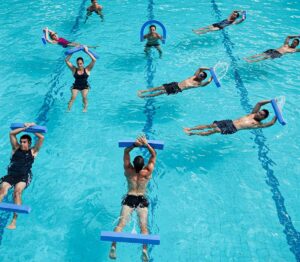Introduction to Swimming as a Fitness Activity
Swimming has emerged as a popular form of exercise, particularly within gym environments, where accessible pools offer a versatile and effective way to enhance one’s fitness level. This unique activity not only caters to a wide range of individuals but also serves various fitness goals, making it a favorable choice for many. As a low-impact exercise, swimming is suitable for people of all ages and abilities, including those recovering from injuries or seeking to better their cardiovascular health.
One of the significant advantages of swimming is its ability to provide a full-body workout. When engaging in swimming, multiple muscle groups are recruited, leading to enhanced strength and endurance. Unlike traditional workout methods that may emphasize only specific muscle areas, swimming encourages balanced development, contributing to overall functional fitness. This characteristic sets it apart from other activities, such as running or weightlifting, which may place added stress on specific joints and muscles, thereby increasing the risk of injury.
Another appealing aspect of swimming as a gym activity is its personalization. Individuals can tailor their swimming workouts based on personal fitness levels and aspirations. Whether one seeks to lose weight, build muscle, or improve cardiovascular health, the adaptability of swimming can support diverse objectives. Techniques such as varying stroke styles or implementing interval training can keep the workout fresh and challenging, allowing individuals to continually progress and stay engaged.
Additionally, the soothing nature of water serves to reduce stress and alleviate tension, promoting mental well-being alongside physical benefits. The rhythmic movement through water can be meditative, thereby offering an emotional outlet while exercising. Consequently, swimming stands out not only as a robust fitness activity but also as a means of enhancing overall quality of life.
Full-Body Workout: Engaging Multiple Muscle Groups
Swimming is often hailed as one of the most efficient full-body workouts available, and for good reason. This unique form of exercise engages a multitude of muscle groups simultaneously, providing a comprehensive approach to fitness that few other activities can match. When a swimmer glides through the water, a variety of muscle groups, including the arms, legs, core, and back, are activated, leading to a balanced and effective workout.
Each stroke in swimming offers distinct challenges to the body’s muscle groups, promoting enhanced strength and flexibility. For instance, the freestyle stroke predominantly targets the shoulders, arms, and core, enabling swimmers to develop upper body strength while also working their abdominal muscles for stability. In contrast, the breaststroke engages the legs more intensely, requiring powerful kicks that build muscular endurance in the quadriceps and calves. Similarly, the butterfly stroke incorporates a vigorous motion that not only strengthens the chest and back but also enhances overall cardiovascular fitness. The unique demands of each stroke allow swimmers to train different muscle groups, contributing to a well-rounded physique.
Furthermore, swimming promotes flexibility due to the range of motion required for effective strokes. The rotational movements in freestyle and backstroke, for example, stretch the muscles and joints, fostering greater flexibility over time. This aspect of swimming is particularly beneficial for individuals seeking to improve their overall physical performance in other activities or sports.
By participating in swimming as a regular exercise regimen, individuals benefit from a full-body workout that builds strength, enhances flexibility, and promotes cardiovascular health. This versatile form of exercise not only helps in achieving fitness goals but also contributes to overall well-being.
Low-Impact Exercise: Gentle on the Joints
One of the foremost advantages of swimming in a gym pool is its low-impact nature, making it an exceptionally suitable exercise option for individuals of all ages and varying fitness levels. Swimming is particularly beneficial for those recovering from injuries or living with chronic joint pain, as it allows users to engage in physical activity without placing undue stress on their bodies.
The buoyancy provided by water significantly reduces the weight-bearing demands on joints. When submerged, a person’s body weight is less than it is on land, resulting in diminished impact on knees, hips, and the spine. This reduction in gravity’s influence enables swimmers to perform movements that might be difficult or painful on solid surfaces. As a result, water serves as a therapeutic medium, facilitating mobility and flexibility while preserving the integrity of injured or sensitive joints.
Furthermore, the resistance of water adds a dimension of strength training to the workout without the risk of joint strain associated with traditional gym equipment. Each stroke and kick in the water requires the engagement of various muscle groups, offering a comprehensive workout that can enhance strength, endurance, and overall cardiovascular health. The unique environment also encourages better posture and balance, which is vital for anyone experiencing joint issues.
The structured nature of swimming sessions in a gym pool can be tailored to meet individual recovery goals. Whether one is easing back into exercise after an injury or looking to maintain fitness while managing osteoarthritis, swimming offers a viable solution. As such, it is essential to recognize swimming not merely as a recreational activity, but as a pivotal component of a low-impact exercise regime, providing individuals the opportunity to unlock their fitness potential effectively.
Cardiovascular Benefits: Boosting Heart Health
Swimming is renowned for its extensive cardiovascular benefits, making it an excellent choice for individuals seeking to improve their heart and lung function. Regular swimming provides a full-body workout that engages multiple muscle groups, promotes endurance, and encourages a robust cardiovascular system. The rhythmic nature of swimming necessitates deep, controlled breathing, which facilitates effective oxygen exchange, thereby enhancing lung capacity and overall respiratory health.
When one swims, the heart is subjected to a sustained cardiovascular challenge, creating a scenario where it must pump oxygen-rich blood to the working muscles efficiently. This consistent stimulation leads to physiological adaptations, including increased cardiac output and strengthened heart muscles. Over time, swimmers tend to display lower resting heart rates, which is indicative of enhanced heart efficiency. Consequently, this activity not only reduces the risk of heart disease but also aids in managing existing conditions.
To incorporate swimming into a heart-healthy fitness regimen, it is advisable to set realistic goals based on individual fitness levels. For beginners, starting with shorter sessions, such as 20-30 minutes, can be beneficial as it allows the body to adapt gradually. Progressively increasing the duration and intensity of swimming sessions can better optimize cardiovascular results. Incorporating various strokes, such as freestyle, breaststroke, and backstroke, not only adds variety but also targets different muscle groups, further enhancing the heart’s performance.
Engaging in swim workouts a few times each week can significantly contribute to improved cardiovascular endurance and heart health. Moreover, it is essential to pay attention to proper hydration and nutrition, as these factors play a vital role in maximizing the overall efficacy of swimming in promoting cardiovascular health. By prioritizing these elements, individuals can unlock their fitness potential and enjoy a heart-healthy lifestyle.
Weight Management: Effective Calorie Burn
Swimming is widely recognized as a highly efficient form of cardiovascular exercise that can significantly contribute to weight management. As an activity performed in water, swimming engages multiple muscle groups simultaneously, promoting both calorie expenditure and muscle toning. The number of calories burned while swimming can vary depending on several factors, including the swimmer’s weight, the intensity of the workout, and the duration of the session.
According to various studies, an individual weighing around 155 pounds can burn approximately 400 to 500 calories per hour when swimming at a moderate pace, with this number increasing as the intensity intensifies. For instance, vigorous swimming strokes, such as freestyle or butterfly, can result in burning upwards of 700 calories in the same time frame. Such statistics highlight swimming as an effective choice for those aiming to manage their weight.
Incorporating swimming into a regular fitness routine can be particularly beneficial for weight loss, as the water’s buoyancy allows individuals of all fitness levels to perform the exercise without undue strain on the joints. This quality makes swimming an excellent option for people who are overweight or have physical limitations that may hinder other forms of exercise.
Furthermore, the flexibility of swimming allows for various training methods, such as interval training, which can boost calorie burn efficiently. By alternating periods of high intensity with lower intensity swimming, participants can maximize calorie expenditure while also enhancing cardiovascular fitness. This approach not only aids in weight loss but also promotes sustained fat loss by increasing metabolic rate even after the workout has concluded.
Therefore, for individuals seeking to optimize their weight management efforts, swimming in a gym pool stands out as a valuable, effective avenue for achieving their fitness and weight goals.
Mental Health Benefits: Stress Relief and Mood Enhancement
Swimming in a gym pool has been shown to provide significant mental health benefits, particularly in the areas of stress relief and mood enhancement. Research indicates that engaging in physical exercise, such as swimming, has a profound impact on the overall well-being of individuals by reducing symptoms of anxiety and depression. The repetitive nature of swimming strokes, coupled with the soothing quality of being submerged in water, creates an environment that fosters relaxation and mental clarity.
Numerous studies have established a robust link between aquatic exercise and improvements in mood. The act of swimming releases endorphins, which are chemicals in the brain known for their ability to alleviate pain and promote feelings of happiness. This natural boost contributes to an enhanced mood and a decrease in stress levels. Moreover, the rhythmic breathing patterns involved in swimming can serve as a form of meditation, helping individuals to clear their minds and focus solely on the movement and sensation of the water.
Another aspect of swimming’s mental health benefits is its role in enhancing cognitive function. Engaging in regular aerobic exercise, such as swimming, has been linked to improved memory, concentration, and overall cognitive performance. This is particularly relevant in today’s fast-paced world, where stressors can negatively affect mental acuity. Additionally, the calming nature of water can create a serene atmosphere that promotes mindfulness and encourages individuals to remain present in the moment.
Incorporating swimming into one’s fitness routine can, therefore, serve not only as a physical workout but also as a powerful tool for mental health improvement. Overall, the effects of swimming on both stress relief and mood enhancement underline its value as a holistic approach to health and well-being.
Swimming Techniques: Tips for Beginners
Swimming is a highly beneficial form of exercise that can contribute significantly to overall fitness. For beginners, mastering effective swimming techniques is crucial to maximize the benefits and enjoyment of this activity. One of the most essential tips for newcomers is to start with the correct body position in the water. Maintaining a streamlined posture allows for better buoyancy and reduces drag, enabling a more efficient swim. Beginners should focus on keeping their head in line with their body and their hips close to the surface.
Another important aspect of swimming is learning proper breathing techniques. Coordination of breath with strokes is vital for endurance and performance. Beginners should practice exhaling underwater and taking quick, efficient inhales when turning their head to the side. It’s helpful to spend time familiarizing oneself with the rhythm of breathing in conjunction with swimming strokes. Practicing this outside of the pool—such as on dry land—can dramatically enhance comfort in the water.
Additionally, engaging with a coach or instructor can provide invaluable guidance in refining swimming skills. A trained professional can offer personalized feedback and help identify areas for improvement. They can also introduce effective drills tailored to enhancing specific techniques, such as kicking or arm movements, which are integral to swimming. Beginners should not hesitate to seek assistance; this collaboration can expedite learning and lead to more gratifying swimming experiences.
As each individual progresses at their own pace, embracing a consistent practice schedule is essential for developing swimming proficiency. Just like any skill, regular practice will build confidence and enhance one’s swiftness in the pool. By focusing on these techniques and seeking support when needed, beginners can unlock their fitness potential through swimming effectively.
Setting Realistic Fitness Goals with Swimming
Establishing realistic fitness goals is crucial for achieving success in any exercise regimen, including swimming. To begin, it is essential to assess your current fitness level and clearly define what you aim to accomplish. This could range from improving endurance, enhancing technique, or participating in swim events. By identifying specific outcomes, you can devise a focused plan that incorporates swimming into a broader fitness strategy, allowing for both skill development and general conditioning.
When setting swimming-related goals, consider applying the SMART criteria: Specific, Measurable, Achievable, Relevant, and Time-bound. For instance, instead of merely aiming to swim more frequently, a specific goal might be swimming three times a week for 30 minutes, with the intention to increase this duration over time. This level of specificity aids in setting performance benchmarks that can be tracked effectively, providing a sense of accomplishment as milestones are achieved.
Tracking progress is paramount in maintaining motivation and adjusting goals as necessary. Utilizing tools such as swim logs or fitness apps can be beneficial in monitoring improvements in lap times, distance swum, or even technical proficiency. Regular assessments can help to reflect on achievements and identify areas for further development. Furthermore, engaging with fellow swimmers or joining a swim club can provide support, encouragement, and additional inspiration to adhere to your fitness plan.
Lastly, integrating swimming with other exercises can create a comprehensive fitness routine. Balance your swimming workouts with activities such as strength training or flexibility exercises to promote overall health and prevent injury. By recognizing the value of swimming in your broader fitness endeavor and setting attainable goals, you will unlock your true fitness potential while enjoying your journey through the water.
Conclusion: Embracing Swimming for Long-Term Fitness Success
In conclusion, swimming in a gym pool offers a multitude of benefits that can significantly enhance an individual’s fitness journey. The low-impact nature of swimming makes it an ideal exercise for people of all ages and fitness levels, allowing for effective cardiovascular workouts while minimizing the risk of injury. The resistance of water inherently provides a full-body workout, enabling swimmers to strengthen various muscle groups simultaneously, thus improving overall strength and tone.
Moreover, the act of swimming promotes flexibility and can improve endurance, essential components in any fitness regimen. Regular engagement in swimming not only fosters personal discipline but also provides an enjoyable and refreshing alternative to traditional exercise routines. The soothing properties of water can aid in stress relief, contributing to improved mental health, which is crucial for maintaining a consistent fitness regime.
As discussed, swimming also offers a unique opportunity for social interaction. Joining a gym with a swimming pool allows individuals to partake in group classes or swim with friends, encouraging motivation and accountability—two critical factors to achieve fitness goals. Furthermore, the accessibility of swimming pools in gyms enhances convenience, allowing members to incorporate swimming into their regular workouts easily.
For those seeking a long-term commitment to their health and well-being, embracing swimming as a primary element of their fitness arsenal can yield fruitful results. It is time to consider the transformative power of swimming, both physically and mentally. By prioritizing the incorporation of swimming into personal fitness strategies, individuals can unlock an enriching pathway to overall health and wellness that stands the test of time. Joining a gym with a swimming pool is a proactive step towards achieving and maintaining fitness success.



